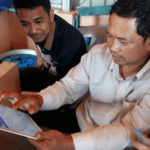A New How-To Guide Chronicles Food and Water Innovators
It is challenging to start a business in mature markets. Now imagine trying to run a business in a rural community in a developing country with poor roads and customers that cannot pay you.
Any road to success is often marked by potholes, hazards and serpentine curves. And successful innovation rarely comes with a how-to manual.
But development pros have provided just that in “Innovator Guidebook: Navigating Business Models for the Base of the Pyramid in Water and Energy for Food.”
The guidebook was unveiled Oct. 23 in San Francisco at Social Capital Markets (SOCAP), a convening of investors, entrepreneurs and social impact leaders.
It was created by Ben Amick, Senior Advisor for Resonance, as well as development leaders at the U.S. Agency for International Development (USAID), and the governments of Sweden, South Africa and The Netherlands.
Amick didn’t start from scratch on the book. His editorial team drew lessons from innovators funded by the groundbreaking five-year Securing Water for Food (SWFF) Grand Challenge. SWFF used a “Shark Tank” like approach to grow more food with less water. The program provided funding for entrepreneurs providing innovative technology solutions for farmers in developing countries.
The 24 innovators from around the world entered into stiff competition to receive funding and strategic technical and business advice through the SWFF program. Innovations included creative irrigation methods, new tools to increase crop yield, and drought-resilient seeds.
It wasn’t easy.
The entrepreneurs used SWFF funds to grow their companies. If they met specific goals for growth and outside investment, they stayed in the program and received more assistance. If they did not, they were out. It was a true “sink or swim” approach that rewarded real results.
Often, after strategic advice from SWFF’s Technical Assistance Facility run by The Kaizen Company, a key pivot was the difference between failure and success. This gave Amick and his team the building blocks to develop the guide, so that future innovators and entrepreneurs could have a leg up.
“Basically, it’s a practical, insightful analysis on how to help entrepreneurs in these difficult markets to overcome challenges unique to frontier markets to turn their businesses into sustainable and profitable ventures,” said Amick. “The bottom line is that when you work in scaling innovations in agriculture in frontier markets, you have a lot to consider. Can poor farmers pay the price for the innovator’s product? How can you engage low-income distributors in your supply chain? How do you work with mom and pop manufacturers to reach volume? In other words, it’s much different from how you work in mature markets,” he added. “The fact is, we don’t know all the right answers necessarily, but we have found out from the innovators how they overcome these challenges. We believe in pulling the solutions from the innovators.”
Amick described the book as the first deliverable of the new program, Water and Energy for Food (WE4F), an initiative that aims to scale small and growing enterprises (SGEs) working in the sectors of food and water, food and energy, or all three sectors at the nexus (food, water, energy).
“We’re not reinventing the wheel here but drawing on SWFF experiences over the last five years to improve WE4F,” explained Amick. “The primary audience is entrepreneurs, while secondarily, we want it to be of use to incubators, donors and investors looking to help innovators succeed in the market.”
Amick said his team interviewed 30 innovators to compile material for the 100-page book. “We wanted to produce a practical tool, but we are not introducing it strictly in terms of raising capital since the challenges are much more nuanced on how to accelerate a frontier market-based business in the WE4F nexus,” he added.
For both SWFF and the upcoming WE4F Challenge, each innovation has to inch toward sustainability and scalability while being environmentally sound. However, there are multiple measures for success, including the number of beneficiaries reached and whether the status of women in the market has been elevated from second-class citizens to equal footing.
“I am optimistic about the future if we can shift donor support to accelerate innovation-driven enterprise entrepreneurship in frontier markets,” said Amick. “Working with a wide group of partners, I think we can do it. A lot more people must be engaged, including multinational corporations that are sourcing from farmers the world over.”
The fact is the mission is truly one in which, as the movie line goes, “failure is not an option.”
By 2050 it is projected that the world’s population will top 9 billion with sufficient usable, year-around water to accommodate only a third of that number.
USAID, Sweden through the Swedish International Development Cooperation Agency, and the Governments of The Netherlands and South Africa invested $34 million in Securing Water for Food (SWFF) to promote science and technology solutions that enable the production of more food with less water and/or make more water available for food production, processing, and distribution.
Dr. Ku McMahan serves as Team Lead for Securing Water for Food: A Grand Challenge for Development (SWFF) in the US Global Development Lab at USAID.
Top image credit: “Innovator Guidebook: Navigating Business Models for the Base of the Pyramid in Water and Energy for Food.”
- Categories
- Agriculture, Education, Energy, Technology



